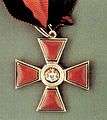Order of Saint Vladimir
| Imperial Order of Saint Prince Vladimir Орден Святого Владимира | |
|---|---|
 | |
| Star of the Order | |
| Awarded by | |
| Type | Dynastic Order |
| Royal house | House of Romanov |
| Religious affiliation | Russian Orthodox |
| Ribbon | Black with a Red stripe in the middle. |
| Motto | Benefit, Honour and Glory |
| Status | Rarely constituted |
| Sovereign | Grand Duchess Maria Vladimirovna of Russia |
| Grades (w/ post-nominals) | Knight/Dame Grand Cordon Knight/Dame Grand Officer Knight/Dame Commander Knight/Dame |
| Established | 22 September 1782 1782–1918 (National Order) 1918–present (House Order) |
| Precedence | |
| Next (higher) | Imperial Military Order of St. George |
| Next (lower) | Imperial Order of St. Anna |
| | |
| The Ribbon of the Order | |
The Order of Saint Vladimir (Russian: Орден Святого Владимира) was an Imperial Russian Order established in 1782 by Empress Catherine II in memory of the deeds of Saint Vladimir, the Grand Prince and the Baptizer of the Kievan Rus'.
Grades
The order had four degrees and was awarded for continuous civil and military service. People who had been awarded with the St.Vladimir Order for military merits bore it with a special fold on the ribbon - "with a bow". There was a certain hierarchy of Russian Orders. According to this, the St. Vladimir Order, 1st Class was the second one (the first - St. George Order) by its significance. According to the Russian Law about the Nobility, people who were awarded with the St. Vladimir Order (each class) had had the rights of hereditary nobility until the Emperor's Decree of 1900 was issued. After this only three first classes of the Order gave such a right. Today, HIH Grand Duchess Maria Vladimirovna, pretender to the Russian throne, and Head of the Russian Imperial House continues to award the Russian Imperial Order of Saint Vladimir as a dynastic order of knighthood.[1] This is disputed by some historians and by some members of the Romanov Family Association. [2]
First class of the order - A red cross with black and golden borders. The badge of the Order depended from a sash worn over the right shoulder, and a gold-and-silver eight-rayed star was fastened on the left chest.
Second class - The red cross on the neck and the star on the left chest.
Third class - The red cross of a smaller size on the neck.
Fourth class - The same on the left chest.

Insignia
Badge: A red enamelled cross pattée with black enamelled borders, and a black enamelled central disc bearing a crowned red and ermine mantle with the monogram of St. Vladimir. Worn on a sash by the first degree, on a necklet by the second and third degrees, and on a chest ribbon by the fourth degree.
Star: A four-pointed star superimposed upon a four-pointed gold star, with a golden cross pattée and the letters "CPKB" between the arms of the cross on a black enamel background at the centre surrounded by the motto of the order "Benefit, Honour and Glory" (Pol'za, chest' i slava). Worn on the left chest by the first and second degrees. This motto was transferred to present-day star of the Order of Merit for the Fatherland, which was established in 1992 by President Boris Yeltsin and is today the second highest ranking decoration of that country.
Ribbon: red with wide black edges.
 Historical Order of third degree
Historical Order of third degree- Cross of the 4th Class with Swords
Order of Saint Vladimir of the Russian Orthodox Church
In 1957, in commemoration of the 40th anniversary of the Patriarch's restoration in Russia, an Order of Saint Vladimir was created by the Russian Orthodox Church. The order is to be awarded to priests and nuns of Orthodox church for their service to Soviet Union and later Russia. There are three degrees of the order.[3] It has no relation to the former imperial order.[4]
.jpg) Russian Orthodox Church Order of St. Vladimir, first degree
Russian Orthodox Church Order of St. Vladimir, first degree.jpg) Modern Order of St. Vladimir, second degree
Modern Order of St. Vladimir, second degree.jpg) Modern Order of St. Vladimir, third degree
Modern Order of St. Vladimir, third degree
Select recipients
- Abbasgulu aga Bakikhanov Gudsi
- Charles Broke Vere
- Angus Buchanan
- Anto Gvozdenović
- Jacob van Deventer
- Robert Henry Dick
- Ivan Gannibal
- Alexander Kolchak
- Louis-Mathieu Langlès
- Mikhail Lermontov was to be awarded the Fourth Class of the Order but never received it. His name was removed from the final list of recipients by Czar Nicholas I, who harbored a strong dislike for the stubborn poet.[5]
- Mitrofan Lodyzhensky
- Fyodor Matisen
- Igor Sikorsky
- Pyotr Stolypin
- Jovan Sundečić
- Pyotr Ilyich Tchaikovsky
- Nikolai Yudenich
- Mikhail Tukhachevsky
- Ilya Ulyanov, Vladimir Lenin's father
References
- ↑ "Императорский Орден Святого Равноапостольного Великого Князя Владимира". Russian Imperial House. Retrieved 25 March 2014.
- ↑ Sainty, Guy Stair (2006). World Orders of Knighthood and Merit. London: Burke's Peerage. ISBN 0971196672.
- ↑ "Орден святого равноапостольного великого князя Владимира" (in Russian). Eparchy of Kazan. Retrieved 2012-11-29.
- ↑ "Russian Heraldry as It is /". The.heraldry.ru. 2006-11-14. Retrieved 2012-11-29.
- ↑ Vyacheslav Rumyantsev (August 11, 2003). "Валерик" [Valerik]. Cronus. Retrieved March 3, 2011. (Russian)
| Wikimedia Commons has media related to Order of Saint Vladimir. |
